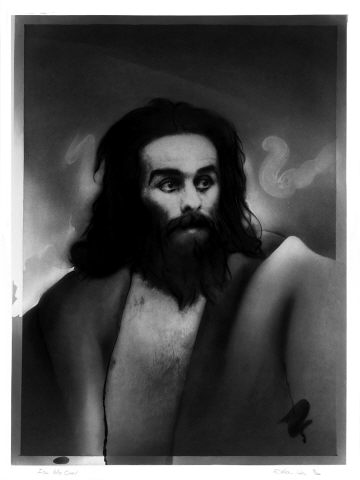
- 1983
- Paper
- Photo print
- Inv. 98GE598
Richard Hamilton
Finn MacCool
A seminal figure in the history of Pop Art, Richard Hamilton artistically imagined James Joyce’s 1922 modernist novel Ulysses over the course of fifty years. The portrait Finn MacCool belongs to this series, picturing Irish Republican Army (IRA) prisoner Raymond McCartney whilst at the HM Prison Maze in Northern Ireland. Hamilton’s work appropriates a shocking media image of an emaciated McCartney participating in a notorious hunger strike in 1980, which aimed to gain some prisoner of war rights for the inmates. The Loyalist, Protestant majority, who wanted to maintain the British rule over Northern Ireland, locked up McCartney and many others who aligned with the Nationalist, Catholic minority fighting for Northern Ireland to join the Republic of Ireland. This constitutional conflict has caused a series of battles known as ‘The Troubles’.
The title of this work is the Anglicised name of a legendary Irish giant who is portrayed as a great warrior and protector of Ireland in popular folklore. Hamilton drew similarities between this ancient giant and a character simply called “the citizen” in the Cyclops episode of Ulysses. “the citizen” is characterised by Joyce as nationalistic, xenophobic and as only internalising a single perspective, making him ‘one-eyed’. Conclusions can be drawn that Hamilton is envisioning a contemporary version of Joyce’s “the citizen”, however the artist does not depict McCartney as an unfavourable narrow-minded villain. Instead, Hamilton has accentuated certain aspects of the black and white media image of a longhaired, bearded McCartney, allowing the image to take on visual similarities to popular depictions of Christ. The artist erased any identifiable signifiers of time and location in the background, clothed the starved man in a robe and manipulated the photographic quality of the image, so that it appears painterly and dream-like. By altering the original photograph to encourage a divine connection, Hamilton has imbued this image with notions of holy wisdom and kindness. Considering the two Christian groups in conflict, Hamilton’s Christ-like McCartney could be viewed as saintly or blasphemous.
In line with Pop Art’s tendency to combine images and ideas from both high and low culture, Hamilton has used different sources in this image. Taking inspiration from Irish folklore, a revered literary work and contemporary events portrayed by the media, Hamilton has designed a loaded political image that could be seen as venerating a martyr of the Republican uprisings, ironically presenting a false idol or depicting a humanitarian who has become a cult-object via media attention.
Olivia Welch
| Type | Value | Unit | Section |
| Height | 76 | cm | |
| Width | 56 | cm | |
| Height | 53,7 | cm | |
| Width | 40,3 | cm |
| Type | Acquisition |
| 1/150 Gravar e Multiplicar |
| Almada, Casa da Cerca - Centro de Arte Contemporânea, 2009 |
| ISBN:9789728794583 |
| Catálogo de exposição |
| 1/150 Gravar e Multiplicar - Gravuras da Colecção do Centro de Arte Moderna da Fundação Calouste Gulbenkian |
| Casa da Cerca - Centro de Arte Contemporânea |
| Curator: Casa da Cerca - Centro de Arte Contemporânea |
| 31 de Janeiro de 2009 a 17 de Maio de 2009 Casa da Cerca |
| exposição comissariada por Ana Vasconcelos, Emília Ferreira e António Canau (Comissário científico). |